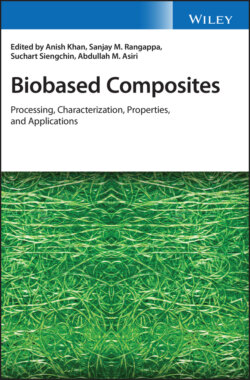Читать книгу Biobased Composites - Группа авторов - Страница 12
1.1 Introduction
ОглавлениеTons of industrial wastes are dumped daily in every region of the world, making the recycling of these wastes a very critical environmental concern. For environmental‐friendly industries, materials from renewable resources should be used to replace conventional materials. Hence, the sustainability will be ensured, and cheaper as well as ecological alternative products will compete with the current products from nonrenewable resources [1–3].
Biobased composite materials and green products are increasingly substituting the traditional materials and products in a wide range of applications for sustainable industries, though massive efforts are still essential to better exploit such biomaterials as well as to expand their applications [4–6]. Moreover, the necessity to advance their potentials for consistent and reliable performance is still demanding [7]. To achieve these goals, founding a well‐organized and robust evaluation and selection system for the composite constituents is the most important step [8, 9]. In such techniques, several preferred fibers as well as polymer assets including mechanical, physical, economic, and environmental, have to be revealed in parallel and assessed to determine the best type of fibers for a certain application [9–11]. Further, proper capabilities and performance of new materials including the biobased ones, would enhance their industrial applications.
The weather, on the other hand, is also reaching more extremes in both hot and cold conditions and negatively affecting the available resources and the environment. Ice formation is sharply decaying over the past years due to climate changes. It is believed that the fast‐increasing manner of temperature over years due to global warming leads to shorter winters, breaking the natural balance in climate resulting in the destruction of available resources. The rising of sea level due to melting of ice is also a serious problem that can lead to catastrophic disasters on the sea‐neighbor lands, which would negatively affect the environment. Natural fibers are considered renewable resources and can be recycled from many industrial process wastes. These natural fibers are obtained from plant sources, such as hemp, or from animal sources [12, 13]. Natural fibers of plant sources comprise cellulose, hemicellulose, and lignin; natural fibers of animal sources consist of mainly proteins. Natural fibers can be utilized in various sizes from macro‐ to nanoscale fibers. For instance, the nanocellulose fibers can be utilized in a wide range of applications as indicated in Figure 1.1.
Figure 1.1 Nanocellulose applications.
Figure 1.2 Illustration for the structure of cellulose extracted from plants.
Figure 1.2 illustrates the structure of cellulose extracted from plants as a 3D illustration showing the plant cross‐sectional walls, hemicellulose, lignin, fibril, microfibrils, the amorphous region, and cellulose.
In general, the natural fibers are used in polymer composites as reinforcement [14–17]. Hence, the properties of these composites will directly be influenced by the type of fibers used, their aspect ratio (length/width), their extraction processes, and their interaction with the matrix material [18–20].
